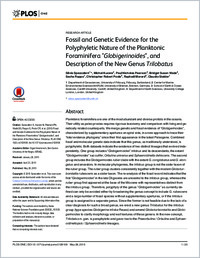Fossil and genetic evidence for the polyphyletic nature of the planktonic foraminifera ‘Globigerinoides’, and description of the new genus Trilobatus
- Spezzaferri, Silvia Department of Geosciences, University of Fribourg, Switzerland
- Kucera, Michal Department of Geosciences, University of Fribourg, Switzerland
- Pearson, Paul Nicholas School of Earth & Ocean Sciences, Cardiff University, United Kingdom
- Wade, Bridget Susan Department of Earth Sciences, University College London, United Kingdom
- Rappo, Sacha Department of Geosciences, University of Fribourg, Switzerland
- Poole, Christopher Robert Department of Earth Sciences, University College London, United Kingdom
- Morard, Raphaël Department of Geosciences, University of Fribourg, Switzerland
- Stalder, Claudio Department of Geosciences, University of Fribourg, Switzerland
-
28.05.2015
Published in:
- PLoS ONE. - 2015, vol. 10, no. 5, p. e0128108
English
Planktonic foraminifera are one of the most abundant and diverse protists in the oceans. Their utility as paleo proxies requires rigorous taxonomy and comparison with living and genetically related counterparts. We merge genetic and fossil evidence of “Globigerinoides”, characterized by supplementary apertures on spiral side, in a new approach to trace their “total evidence phylogeny” since their first appearance in the latest Paleogene. Combined fossil and molecular genetic data indicate that this genus, as traditionally understood, is polyphyletic. Both datasets indicate the existence of two distinct lineages that evolved independently. One group includes “Globigerinoides” trilobus and its descendants, the extant “Globigerinoides” sacculifer, Orbulina universa and Sphaeroidinella dehiscens. The second group includes the Globigerinoides ruber clade with the extant G. conglobatus and G. elongatus and ancestors. In molecular phylogenies, the trilobus group is not the sister taxon of the ruber group. The ruber group clusters consistently together with the modern Globoturborotalita rubescens as a sister taxon. The re-analysis of the fossil record indicates that the first “Globigerinoides” in the late Oligocene are ancestral to the trilobus group, whereas the ruber group first appeared at the base of the Miocene with representatives distinct from the trilobus group. Therefore, polyphyly of the genus "Globigerinoides" as currently defined can only be avoided either by broadening the genus concept to include G. rubescens and a large number of fossil species without supplementary apertures, or if the trilobus group is assigned to a separate genus. Since the former is not feasible due to the lack of a clear diagnosis for such a broad genus, we erect a new genus Trilobatus for the trilobus group (type species Globigerina triloba Reuss) and amend Globoturborotalita and Globigerinoides to clarify morphology and wall textures of these genera. In the new concept, Trilobatus n. gen. is paraphyletic and gave rise to the Praeorbulina / Orbulina and Sphaeroidinellopsis / Sphaeroidinella lineages.
- Faculty
- Faculté des sciences et de médecine
- Department
- Département de Géosciences
- Language
-
- English
- Classification
- Palaeontology
- License
-
License undefined
- Identifiers
-
- RERO DOC 257204
- DOI 10.1371/journal.pone.0128108
- Persistent URL
- https://folia.unifr.ch/unifr/documents/304529
Statistics
Document views: 146
File downloads:
- pdf: 265
